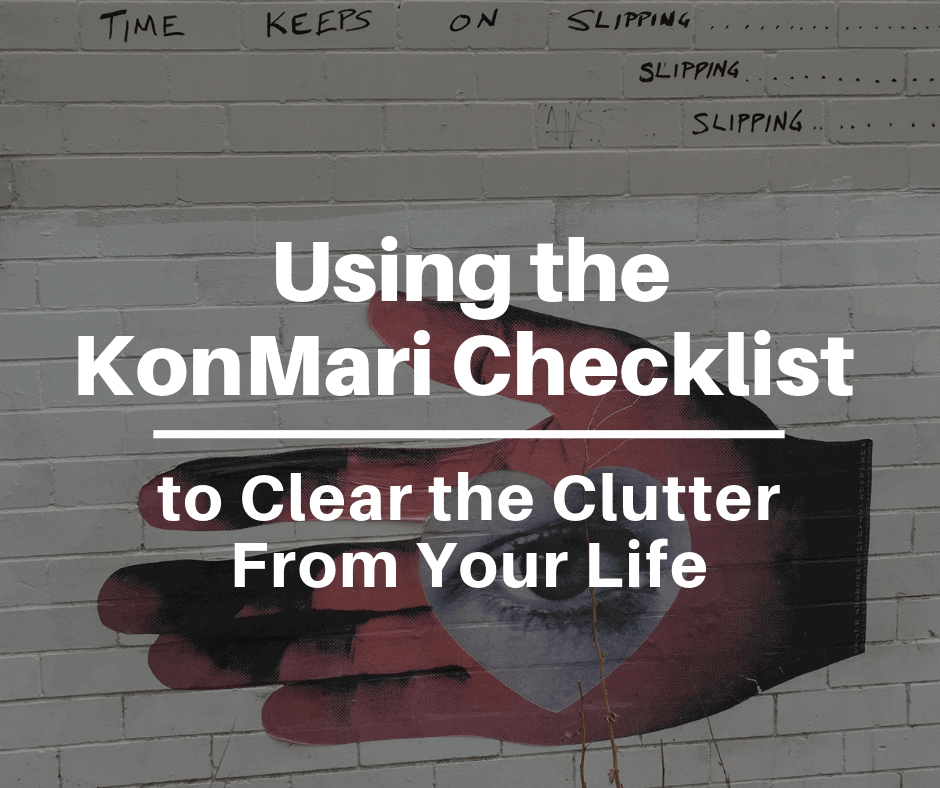This is a sponsored post in partnership with National Business Furniture. Please note that this article contains affiliate links.
The new Netflix series, “Tidying Up With Marie Kondo” (featuring bestselling author and decluttering expert Marie Kondo) couldn’t have come at a more opportune time, especially since the new year has just begun (at least as of this publication!).
The Netflix series features people and families who are a little overwhelmed with the accumulation of stuff that makes up their living space. Kondo’s KonMari method encourages people to say goodbye to the things that no longer bring them joy — one of the simplest but most effective ways to give yourself permission to declutter.
Jump Ahead to a Specific Section:
A Guide to Decluttering, Using the KonMari Checklist
The KonMari method is different than other popular organization methods because it advocates tidying up according to category — not by area. By piling up all your items that are part of a related category, you get a better idea of just how much stuff you really have (which will then motivate you to cut down on duplicate items).
The major categories in the KonMari checklist include:
- Clothes
- Books
- Papers
- Komono (miscellaneous items)
- Sentimental
To declutter, hold each item and ask yourself whether it sparks joy.
Yes, you must touch every item to see how your body reacts. If it does not spark joy, respectfully thank it for being of use in your life and let it go.
Here’s a common question that comes up when going through the KonMari checklist:
How do you deal with the someday items — the items you think you’ll wear or need some time in the future?
For this, Marie Kondo says that when possessions aren’t used, they are stripped of their dignity, so the most positive thing you can do for them is let them go.
Let’s go through each category of the KonMari checklist to share specific strategies that will help clear the clutter in your life.
Clothes
A great first step is to start with your clothes. Most people have so many pieces that they never use.
Consider further breaking down this category in terms of the following clothing subcategories:
- Tops
- Bottoms
- Underwear
- Outerwear
- Formalwear
- Swimwear
- Outerwear
- Seasonal
- Dresses
- Jackets
- Outerwear
- Sweaters
- Sleepwear
- Socks
- Activewear
- Shoes
- Accessories
After you’ve determined all the clothing items you want to keep, consider the KonMari method of folding for efficient storage:
Then, once you’ve sorted through all the old stuff you were never going to wear anyways, consider upleveling your existing wardrobe with Stitch Fix. You set your own pricing regarding the types of items they include and can share notes regarding specific needs: for example, business attire, a wedding, upcoming vacation, etc.
I’ve been using Stitch Fix for a few months now and recently ordered a box to complement my Portugal vacation. I ended up keeping everything they sent me! Since the stylist behind each box explains the purpose behind their suggestions, the pieces I choose to keep get used instead of adding to existing clutter.
Books
Marie Kondo recommends keeping only 30 books, which sparked outrage on Twitter.
Theoretically, it sounds like a smart idea, but I can’t personally limit myself to just 30 books.
That said, whenever I move, I take the time to get rid of:
- Duplicates
- Books I’ve read that I know I won’t read again
- Books I’ve accumulated that I know I’ll never actually read
Additionally, whenever people stay over in my guest room, where we have our two big bookshelves, I encourage them to look through my little library and take a volume if they are compelled to! This has been a satisfying way to reduce clutter and rehome my favorite novels.
I keep most of my business books separate, in my National Business Furniture storage cabinet, so that I can refer back to them as necessary!
Komono (aka, Miscellaneous)
The komono category of the KonMari checklist encompasses everything that isn’t clothes, books, or sentimental items.
So where to start? Consider decluttering with these subcategories:
- Electronics: phones, laptops/tablets, chargers, camera, headphones, cords
- Kitchen: towels, plates, glasses, utensils
- Bedroom: beddings, blankets, pillows
- Living room: rugs/carpets
- Hobbies: sports equipment, gaming consoles/controllers, art supplies
- Miscellaneous: decorations, cleaning supplies
i know i'll like "tidying up with marie kondo" a minute in because one category encompasses like five rooms of the house and another is just "books" pic.twitter.com/AI5PaUB7Zl
— em cassel (@biketrouble) January 2, 2019
With New Year’s resolutions still fresh on your mind, it’s the perfect time to embrace decluttering by getting rid of anything that isn’t useful, beautiful, or joyful: both in your personal life and home office.
Netflix releasing Tidying Up with Marie Kondo on New Year’s Day pic.twitter.com/PWwWIv84Q8
— Jack (@jackaronan) January 1, 2019
Why You Should Clear the Clutter from your Office
According to a study by Kenton Global, your physical workspace affects your mental workspace.
Having a cluttered workspace affects your ability to focus and process information, which can overload your senses and cause you stress. According to the same study, 62% of those surveyed said that having a cluttered workspace makes them unhappy.
Additionally, according to recent research by National Business Furniture, three out of four supervisors believe that office clutter is a sign of disorganization. Along with a messy personal appearance, these are two of the things preventing them from awarding a promotion.
If you think you have a problem with clutter in your workspace, this adapted KonMari checklist can help you fix that:
#1: Admit You Have a Clutter Problem
ow should you organize the files in your filing cabinet? Alphabetically, chronologically, according to topic?
It’s really up to you, as people’s minds work differently, and some ways of organizing files just click for different folks.
However, here are a few guidelines that can help you visualize your filing system:
- If asked to look for something in your office, do you have trouble locating it?
- Do you have office supplies everywhere (e.g. your office, kitchen, and car)?
- Do you have a hard time letting go of things?
- Has someone teased you about your clutter issue?
- Whenever you attempt to organize your things, do you have a hard time knowing where to start?
Once you admit you have a clutter problem, you can correctly address the issue.
#2: Determine the Root Cause of Your Problem
There are plenty of potential reasons behind why you might allow clutter to accumulate in your life.
These reasons may include:
- Not having enough time to organize.
- Once you admit you have a clutter problem, you can correctly address the issue.
- Psychological reasons like fear of change, fear that you may need the item later, or that the process of accumulating stuff is an ingrained behavior from childhood.
Determining the reason behind your clutter problem isn’t a waste of time. In extreme cases, it may actually be reflective of a mental disorder (like hoarding).
Whatever the reason, getting to the root of why you have an issue parting with certain things will help you understand the right approach to tackle your mess in the rest of this KonMari checklist.
National Business Furniture’s Clear the Office Clutter ebook offers a simple test to determine your clutter personality, in addition to actionable tips for how to get started according to each personality.
#3: Visualize the Destination
The KonMari method advocates that after choosing a day to tidy everything up, and before you start your purge, you visualize what your ideal lifestyle would be.
Have a concrete goal and don’t limit yourself to a broad idea like “I want a clean house” or “I want to live clutter-free.”
When I upleveled my workspace, with help from National Business Furniture, my goal was to accomplish more during my workday, freed by the stresses of not having a functional workspace.
#4: Start the Purge!
At this point in the KonMari checklist, it’s time to set a block of time and start the purge! The next free weekend you have, get to it right away.
thank_u_next_marie_kondo.mp3 pic.twitter.com/Zvu9KOu01D
— Estelle Tang (@waouwwaouw) January 3, 2019
There is no better time to start than now.
Empty your drawers and clear your tables/shelves so that you’ll have a fresh perspective of the space you’re working with, and help you determine what things should go where.
Once you have a clear perspective of all related items, start categorizing your things. You can place similar items or items that complement each other together: whatever works for you.
This makes it easier for you to determine which items you can keep, buy and throw away (or donate!).
Marie Kondo is a fictional character created by Goodwill Industries to get me to donate half of everything I own
— Matt Haughey 😷 (@mathowie) January 2, 2019
Next, follow Marie Kondo’s method and ask yourself whether the item is useful, beautiful or joyful.
For example, family photos aren’t useful to your work, but they can help inspire you when you hit a work stump.
Just remember, you don’t need a pile of them on your desk, maybe just one beautiful framed photo of the people you care about (or put your favorites in an album). When I worked at Groupon, I printed dozens of square photos from my Instagram in white border frames from FoxPrint, which resulted in a beautiful, personalized desk space.
On that note, you don’t need 40 pens — especially if only 3 of them actually have enough ink to write. Be scrupulous when it comes to cutting down on duplicate items.
Finally, determine which items are most important in terms of their frequency of use.
These are the items that should occupy the “prime real estate” space on your shelves and tables and should be within easy reach. Items that you don’t use often should be placed in clear storage boxes or areas far from reach.
#5: Buy Organizers
Though Marie Kondo might say that buying organizers exacerbate the problem of having too much stuff, a modern home office definitely benefits from having additional storage containers.
Once you’ve determined where everything could go, buy organizational products that you don’t already have, such as bookcase organizers, drawer dividers, labels, and filing trays.
Once you see how nice everything looks when it’s organized, it’ll be a lot easier to keep everything in its designated place.
#6: Develop a Filing System
Once you know which papers you need to let go of (e.g. five-year-old memos or checks that were cashed months ago), you’ll want to create a better filing system for your paperwork.
According to the IRS, you should keep records that support an item of income, deduction, or credit shown on your tax return — at least until the period of limitations for that tax return runs out.
This period of limitation is the time in which you can amend your tax return to claim a credit or refund, or when the IRS can assess additional tax. This is usually 3 years from the date you filed your tax return or 2 years from the date you paid your taxes: whichever is later.
Keep records indefinitely if you don’t file a return and check the IRS website for notes regarding other special cases.
Receipts are usually valid anywhere between 50 days to 3 years, depending on what you bought.
For example, gas and electricity bills make for ideal proof of payment and proof of address. If there are any disputes pertaining to these bills, they usually get settled within a year’s time, so bills should be kept for two years at a time. Credit card bills should be kept if you’re expecting a rebate for something.
Important papers to keep:
- Vehicle receipts: they help calculate depreciation if you want to sell your car.
- Jewelry: for valuation reports in insurance companies; alternatively, you can keep relevant warranty cards.
- Records relating to insurance premium payments: unless these are also logged online.
- Home loans and rent and home purchase documents: keep rent receipts for a maximum of six years and keep home loans and home purchase documents permanently as they act as proof of payment and ownership of the house.
Compartmentalize according to the type of receipt and the year it is applicable to (it also makes it easier to dispose of them when the proper time comes).
I use clear plastic envelopes with a label depicting the tax year, for easy storage and recall, inside my mobile filing pedestal.
Some receipts and papers fade over time, so you should scan them for posterity. A receipt scanning app like Neat should help — although I have some beef with them (awful customer service), they’re what I currently use.
With a system in place, the next time you receive a paper and have handled it, don’t just leave it in a pile on your desk — square it away for filing immediately.
Take this to the next level by digitizing important files that can then be accessed anywhere. Blogger Abby Lawson shares tips regarding her family’s paperless filing system on Evernote.
But don’t limit yourself to just your paper files; also take the time to organize your computer files.
Additional tips for digital decluttering:
For your desktop/laptop:
- When you download something, make sure to name the file appropriately and ensure that every file belongs to a dedicated folder. Don’t leave anything on your desktop — that’s just asking for clutter.
- Set a calendar reminder to upload important file folder content to a cloud storage solution like Google Drive periodically — perhaps once a month.
- Use your “Downloads” folder as temporary storage for files you don’t plan to keep. For example, when I’m scheduling social posts for clients, I keep all relevant images in my Downloads folder, sort by date added, and purge said files once I’m done.
- Delete any files and digital documents you won’t use again like old essays and stuff from old projects.
- Backup your most important files on an external hard drive for bonus points!
For your email inbox:
- Unsubscribe from email lists and newsletters you don’t regularly take action on.
- Use filters to send spam emails directly to the trash. You’ll figure out trigger words/senders over time if you just pay attention.
Online accounts:
- Delete rarely used online accounts.
- Delete and unfollow people you don’t know or don’t interact with on your social feeds.
#7: Make it a Habit that Sticks
Once you’ve finished organizing your home office, keep it clean.
Take a few minutes out of your day to put things back in their places (Marie Kondo says you should always showcase the items you use most, and when you’re done, put their items back in their homes) and eliminate paper as much as you can.
Final Thoughts: Using the KonMari Checklist to Clear the Clutter From Your Life
Clearing the clutter from your home office does not have to be an overwhelming task. With this KonMari checklist, you can create a workspace (and home) that will help you be your most productive self.
If you want to dig deeper into how your personality contributes to a clutter problem, check out National Business Furniture’s ebook, Clear the Office Clutter.











